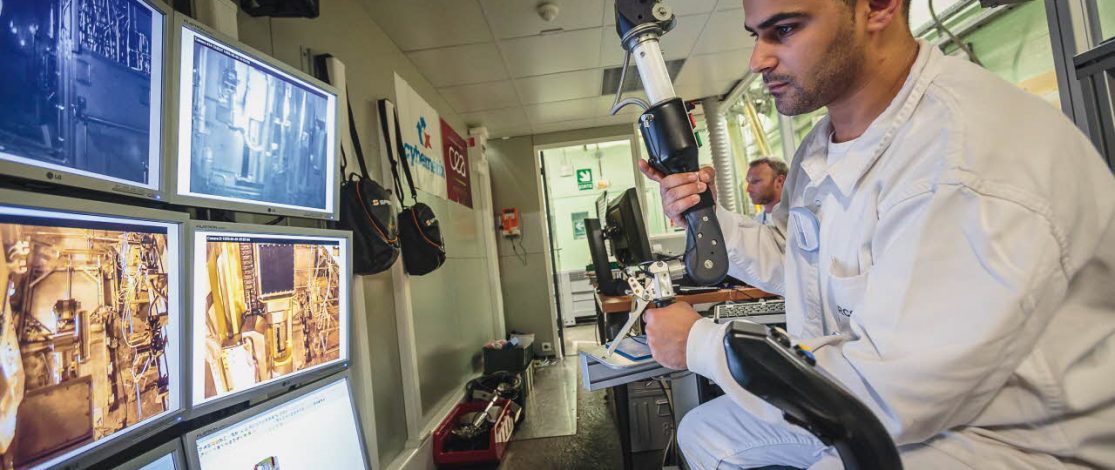With digital technology, we can make significant progress towards reducing the environmental impacts of industrial systems—but digital has a footprint too. It now accounts for nearly 10% of the world’s power consumption, and by 2030 that figure should rise to 20% or 30%. That’s why CEA-List is committed to developing more frugal technologies.
Can digital technology help save the planet? That’s one of the challenges we’re working on at CEA-List. In addition to designing less resource-intensive technologies—especially for embedded systems—we are developing tools that can improve the environment for workers and all citizens.
Digital technologies make production more sustainable by optimizing processes. At CEA-List, we’re developing ways of analyzing the entire life cycle of digital systems, shrinking their carbon footprint and reducing their overall environmental impact.
AI automates a variety of tasks performed in potentially toxic environments. In aeronautics, for example, liquid penetrant testing—a non-destructive method that finds micro-cracks by immersing metal parts in a chemical bath—can be replaced by a system combining thermography with computer-aided vision.
Learn more about Safran’s robotic testing platform, developed in partnership with CEA-List
The kinds of calculations made by AIs are special, and new kinds of processors can help speed them up. Brain-inspired neuromorphic processors are one example. Built on self-assembling magnetic tunnel junctions and resistors, these processors’ electronic neurons make them particularly energy efficient.
Our PNeuro hardware accelerator is found at the core of our SamurAI chip and other innovative architectures such as those developed by Dolphin Design, an integrated circuit manufacturer that has partnered with us to form a joint lab on Edge AI.
Neural network-based deep learning requires large quantities of data, but new methods are finding ways around this problem. Few-shot learning, which trains networks using small datasets, is one of them. In computer vision, for example, few-shot learning means training a network to recognize differences between images rather than the images themselves.
This technique has been applied successfully in medical imaging, enabling an AI to recognize chest organs after training on just a handful of images.
At CEA-List, we’re developing second-generation blockchain technologies that require far fewer calculations than the proof of work-based mining technique used for traditional blockchains.
Learn more about our improvements to the Tendermint blockchain
This means that blockchain can support the rise of a more sustainable economy. At CEA-List, we’re working to apply this technology to energy management in buildings. In one case, we’re logging consumption data from a network of sensors in real time.
In another, we’re providing traceability for green energy. Working in partnership with Bureau Veritas and Engie, we’re developing a blockchain that gives consumers confidence that green products really are green.

Thanks to its hardened electronics and operator assistance capabilities, the remote-controlled Maestro robot has been used to laser-cut materials on nuclear decommissioning projects since 2016. Two operators control the robot from a remote location, working efficiently and in complete safety.
The process of working on and dismantling nuclear sites will soon become easier, thanks to digital “plant memories” being compiled by CEA-List. The resulting database will be searchable with natural-language query systems.
A holistic, interactive digital twin developed by CEA-List is a powerful tool for decommissioning high-risks facilities, including decontaminating and dismantling nuclear sites.
Processes are represented by model-based meta/symbolic descriptions, and physical assets like robots, human operators, and dose evaluation are brought to life through interactive simulation. Both are linked to actual sensor and geolocation data gathered in the field in this powerful digital twin.
It can help users plan interventions efficiently and accurately, train operators, supervise operations, and capture actionable information.
More to explore:
CEA-List, historically a center for nuclear energy research, has solid experience supporting nuclear decommissioning and dismantling projects. We’ve developed advanced instrumentation and robotic technologies for hostile environments. Advanced robotic force control technologies and supervision tools contribute to computer-aided remote handling and operator assistance, simplifying complex tasks with virtual guides and active anti-collision technology. Similarly, our work on smart imagers and embedded AI is driving advances in measurement and data processing.
Together, these technologies give users the tools they need to inspect, decommission and dismantle nuclear sites and sort radioactive waste—while keeping workers safe and making project sites easier to manage.
Learn more about:
For decades, CEA-List has been developing smart instrumentation to measure radiation. These increasingly high-performance systems are improving radiation protection and environmental monitoring. Our solutions rely on precise digital modeling and rapid simulation of radiation-matter interactions. They can be used to design and optimize instrumentation systems, calculate doses received, and ascertain the activation of materials and structures. Digital models like these can be used to develop integrated systems in the form of a prototype with a variety of technologies (sensors or acquisition electronics). The systems also include algorithmic solutions for physical signal analysis coupled with artificial intelligence, giving users reliable data that they can readily interpret.
Learn more about: